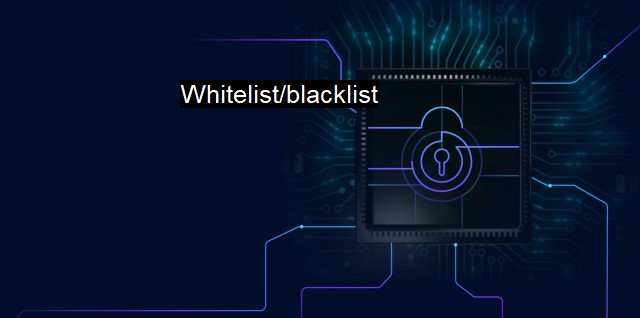What is Whitelist/blacklist?
Understanding the Importance of Whitelist and Blacklist in Cybersecurity and Antivirus Systems: An In-Depth Exploration of Preventative Measures for Hacking and Malware attacks
"Whitelist_blacklist" is fundamentally related to cybersecurity measures and activities in computer systems, applications and networks. It is a method used to filter, categorize, manage and control what is permitted and not permitted within a system environment. While this term is not an officially recognized phrase it represents two distinct lists - a whitelist and a blacklist, often crucial for implementing cybersecurity and antivirus solutions.Let's first define these terms individually:
The concept of "Whitelist" in the context of cybersecurity involves allowing identified, trusted and validated entities (including domains, email addresses, IP addresses or application) to have access to a specific IT system, application or network. Items on this list are considered safe - free from malicious activity and pose no cybersecurity threats. It's a permissive approach, only granting access to those specifically listed on the whitelist.
In an antivirus program, a whitelist might include safe programs and files that shouldn't be flagged or blocked by the antivirus scanner. Another example might be on an email server, where a whitelist contains known, reliable email senders and ensures that their messages aren't marked as spam.
On the other hand, a "Blacklist" refers to a sort of 'red-flag' list that holds all known entities that pose potential threats or harm to the system. These entities can range from domains, IP Addresses, applications, files, of anything unhealthy or harmful that needs to be restrained or prevented from gaining access. In antivirus solutions, a blacklist might contain dangerous applications, known viruses, malware, and spyware that the software should block and prevent from infiltrating the system.
Thus, the concept of "Whitelist_blacklist" might be understood as the implementation of both lists, aiming to securely filter encounters with both internal and external elements in a system or network.
The whitelist and blacklist work complementarily to bolster security measures. While the whitelist ensures a seamless operation of the approved and valid processes, the blacklist prevents, constrains, and isolates potential threats and malicious actors from affecting the system, thereby reducing vulnerability and exposure to cybersecurity risks.
Both whitelisting and blacklisting do have their fair share of drawbacks. Whitelisting, although enhances system security, can sometimes be overly restrictive, potentially blocking unfamiliar but harmless contents. On the other hand, blacklisting is dependent on a comprehensive and updated list of the threats, which might be hard and time-consuming to keep track of considering the evolving and ever-increasing cybersecurity threats.
But regardless of the challenges, Whitelist_blacklist strategies remain an inherent part of today's cybersecurity defenses. By continuously improving the scope and execution of these strategies, including automating the security audits and using machine learning for identifying potential threats, cybersecurity professionals ensure that system administrators can rely on them for an improved robust system and network security.
In sum, the term Whitelist_blacklist, though not officially recognized, illustrates the joint operation of whitelisting and blacklisting strategies to grant access and deny potential threats respectively, thereby providing intelligent and robust solutions to protect computer systems, networks and applications from malicious threats and to enhance their overall reliability and security. With appropriate adjustments, the whitelist and blacklist processes are essential and irreplaceable tools in the realm of cybersecurity and antivirus management.

Whitelist/blacklist FAQs
What is a whitelist in the context of cybersecurity and antivirus?
A whitelist is a list of trusted entities or applications that are permitted to access a particular system or network. It helps to prevent unauthorized access and keeps the system safe from cyber threats.What is a blacklist in the context of cybersecurity and antivirus?
A blacklist is a list of entities or applications that are not trusted and are banned from accessing a particular system or network. It helps to ensure that only authorized entities can access the system and keeps the system safe from potential threats.How do whitelisting and blacklisting differ?
Whitelisting and blacklisting differ in their approach to managing access to a system or network. Whitelisting allows access only to trusted entities, while blacklisting denies access to untrusted entities. Whitelisting is more secure but can be restrictive, while blacklisting is less restrictive but may be less secure.What are the benefits of using a whitelist in antivirus software?
Using a whitelist in antivirus software can help to protect the system from unknown threats by ensuring that only trusted applications are allowed to run. It also reduces the risk of false positives and minimizes the impact of security vulnerabilities. Additionally, it can help to improve system performance by reducing the overhead associated with scanning and monitoring untrusted applications.Related Topics
Application Whitelisting Email Filtering Web Filtering Endpoint Protection Network Segmentation
| | A | | | B | | | C | | | D | | | E | | | F | | | G | | | H | | | I | | | J | | | K | | | L | | | M | |
| | N | | | O | | | P | | | Q | | | R | | | S | | | T | | | U | | | V | | | W | | | X | | | Y | | | Z | |
| | 1 | | | 2 | | | 3 | | | 4 | | | 7 | | | 8 | | |||||||